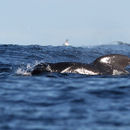Biology
provided by Arkive
This species is exceptionally social, and typically travels in groups called 'pods' of between 10 and 50, and sometimes as many as 100 individuals (2). Their social bonds are so strong that when one individual becomes stranded, others will follow; mass strandings are therefore unusually common in this species (5). Long-finned pilot whales are highly active, they can dive for up to 10 minutes to depths of up to 600m (5).Mating occurs in February and March, after a gestation period of 15 to 16 months the female gives birth (8). The newborn calf measures around 1.9m (2), is nursed for around 20 months and remains with its mother for up to 2 years (8). Females reach sexual maturity at around 7 years of age, whereas males do not become sexually mature until 12 years of age (8).
Conservation
provided by Arkive
The long-finned pilot whale is a UK Biodiversity Action Plan priority species. Under the Wildlife and Countryside Act of 1981, it is illegal to intentionally kill, injure, capture or harass whales and dolphins in UK waters. As the species is listed on Annex A of EU Council Regulation 338/97, it is treated by the EU as if it is included in CITES Appendix I, so that commercial trade is prohibited (4).
Description
provided by Arkive
The long-finned pilot whale is not actually a whale, but a dolphin (5). Along with the related short-finned pilot whale, this species was once called a 'pothead', as the bulbous head was thought to resemble a black cooking pot by the early whalers that first encountered the species (2). The Latin name of this genus, Globicephala, meaning 'globe head' also refers to the shape of the head (6). The stocky body is black or dark grey in colour with a white stripe passing diagonally behind the eye (5), a greyish area on the belly, and an anchor-shaped grey patch on the chin (7). As the common name of this species suggests, the sickle-shaped (7) pectoral fins (flippers) are very long, there is a single blowhole, and the dorsal fin is placed forwards on the body (5). The range of this species and the short-finned pilot whale overlap in some areas, and it can be very difficult to distinguish between the two, particularly as it is often difficult to see the flippers (2).
Habitat
provided by Arkive
Seems to prefer deep water (5). Some populations always remain offshore, whereas others move into inshore waters in pursuit of squid (5).
Range
provided by Arkive
Found in cold temperate to sub-polar waters of both hemispheres (2), including UK waters (5), but has become extinct in the North Pacific (2). It seasonally enters coastal areas around northern Scotland, western Ireland and the south-west English Channel Approaches (4), with sightings in northern Britain concentrated between June and September, and between November and January further to the south (4).
Status
provided by Arkive
Classified as Data Deficient (DD) on the IUCN Red List (1). Listed on Annex IV of the EC Habitats Directive. North Sea and Baltic Sea populations are listed under Appendix II of the Bonn Convention and Appendix III of the Bern Convention (3). All cetaceans (whales and dolphins) are listed on Annex A of EU Council Regulation 338/97; they are therefore treated by the EU as if they are included in CITES Appendix I, so that commercial trade is prohibited. All cetaceans are fully protected under the Wildlife and Countryside Act, 1981 and the Wildlife (Northern Ireland) Order, 1985 (4).
Threats
provided by Arkive
Strandings and entanglement in fishing nets pose problems for this species, but the main threat is hunting (4), particularly coastal hunts (6). For several hundred years, long-finned pilot whales have been hunted off the coasts of the Faroe Islands, (Danish islands in the northeast Atlantic). Whole pods are rounded up by boats and driven towards the coastline where they are dragged ashore and killed. In the last decade, an average of 1,200 individual pilot whales have been killed each year in this way. The Faeroese people defend this hunt fiercely, and maintain that it is long-standing tradition and a source of free protein (2).

